The global Start Stop System Market is expected to grow at a high rate during 2025 to 2035 due to high demand from the fuel-efficient vehicles, environmental problems, and stringent global emission norms.
Start-stop systems automatically switch a vehicle’s engine off when it is idling (such as when stopped at traffic lights) and restart it when the accelerator is pressed reducing gasoline consumption and greenhouse gas emissions. For passenger cars and light-duty commercial vehicles, these systems are increasingly prevalent under all operating conditions, especially in urban operations dominated by stop-and-go.
Government initiatives promoting low-emission vehicles and automotive manufacturers efforts to improve fleet-wide fuel economy without relying on electrification also drive growth. It has also recently been reported that the hybrid electric vehicle market works together with other technologies such as regenerative braking and battery support for start-stop systems.
The start-stop system market globally is anticipated to grow at a CAGR of 14.3% through 2025, to achieve USD 9,253.2 Million in 2025 and approximately USD 35,217.2 Million by 2035.
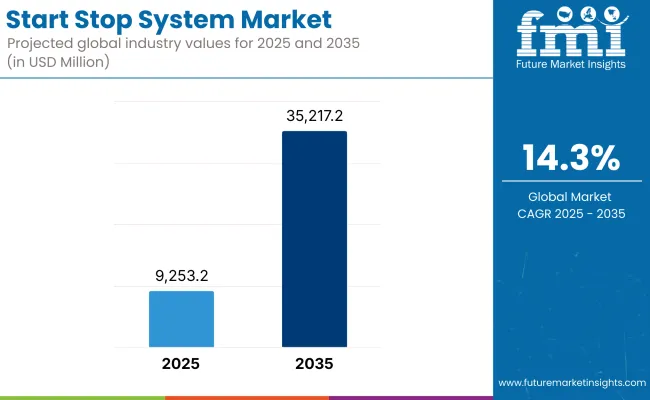
Key Market Metrics
| Metric | Value |
|---|---|
| Market Size in 2025 | USD 9,253.2 Million |
| Projected Market Size in 2035 | USD 35,217.2 Million |
| CAGR (2025 to 2035) | 14.3% |
Due to the strictness in Corporate Average Fuel Economy (CAFE) standards and increasing awareness regarding fuel-saving technology, North America leads the start-stop system market. Compact SUVs and sedans are also the most common vehicles in the USA and Canada and see the most OEM start-stop deployment. Car manufacturers are embedding AGM (Absorbent Glass Mat) and EFB (Enhanced Flooded Battery) technologies to cater these systems.
Europe remains at the forefront of both regulation and adoption. The EU’s CO₂ emissions rules for passenger cars have provided the impetus to couple their entry with start-stop systems as a relatively low-cost compliance technology. Such systems, which have been used over a large segment of vehicle fleets in countries like Germany, France and Italy, At the same time, high urbanization levels and congestion in European cities increase gains from idle-reduction technology.
The Asia-Pacific region is the fastest growing market, followed by China, Japan, South Korea, and India. Tight emission regulations, growing vehicle sales as well as rising fuel prices are driving automakers to fit start-stop systems in a wide array of passenger and light commercial vehicles. With the impending BS-VI and China VI norms, local manufacturers are launching the systems in budget vehicle segments.
System wear, battery life, and consumer perception affect market penetration.
Batteries and starters are stressed more than in the past due to the ubiquitous start-stop systems now on many cars and light trucks, and this presents the biggest problem for the start-stop market. The frequent engine shutdown and restart cycles of the system. Also, start-stop systems demand pricier types of batteries (AGM or EFB) as compared to regular batteries.
There is a barrier by way of consumer perception, too. Some drivers find their system intrusive particularly in cold climates or heavy traffic and disable it manually. It is important because the system has long-term advantages that require people and movement towards that goal. Pricing sensitive markets may also be deterred by aftermarket servicing and replacement component expenses.
Hybrid synergy, fleet adoption, and emissions mandates unlock strong growth potential.
Growing hybrid vehicle production across the globe will boost the market as the foundation of any start-stop system is to make the engine as fuel-efficient as possible and reduce idle emissions. Strategic integration with regenerative braking and advanced driver-assistance systems also adds value. Commercial fleets, especially those focused on delivery and urban logistics, are beginning to deploy start-stop-enabled vehicles to achieve ESG targets and eat into operating costs.
Legislated requirements that automakers must meet average fleet CO₂ limits are a strong driver for implementation of start-stop systems in internal combustion engine (ICE) vehicles. Emerging markets, and in particular those in Southeast Asia and Latin America, are high-growth potential as governments adopt stricter pollution standards and automakers seek inexpensive technologies to enhance efficiency.
Between 2020 and 2024, there was a rapid growth in the adoption of start-stop systems due to tighter fuel economy standards and environmental regulations. This was a reliable and cost-effective way for automakers to move forward without hybridization. COVID-19 pandemic, however, caused disruptions of supply chain due to the lack of availability of key components like advanced batteries and electronic control units.
By 2025 to 2035, the segment will develop in terms of improved system robustness, smarter integration with vehicle control units, and real-time data processing capabilities. To improve engine restarts and cycle endurance, TIC and other manufacturers are implementing enhanced battery chemistries and modular starter-generator designs. Similarly, OEMs will also pair start-stop systems with more eco-features in their mild-hybrid and connected vehicle platforms.
Market Shifts: A Comparative Analysis 2020 to 2024 vs. 2025 to 2035
| Market Shift | 2020 to 2024 Trends |
|---|---|
| Regulatory Landscape | Stricter fuel economy and emission standards |
| Consumer Trends | Growing awareness of idle reduction |
| Industry Adoption | Widespread in passenger cars and premium SUVs |
| Supply Chain and Sourcing | Battery and component shortages due to pandemic |
| Market Competition | Led by automotive OEMs and Tier 1 suppliers |
| Market Growth Drivers | Urban fuel efficiency, emission regulations |
| Sustainability and Impact | Reduced urban emissions and fuel savings |
| Smart Technology Integration | Basic idle-off logic and engine restart timers |
| Sensorial Innovation | Sound dampening and minimal engine vibration |
| Market Shift | 2025 to 2035 Projections |
|---|---|
| Regulatory Landscape | Global alignment on CO₂ thresholds and fleet-level emission compliance |
| Consumer Trends | Preference for seamless, smart-start-stop systems integrated with ADAS |
| Industry Adoption | Growth in LCVs, taxis, and shared mobility fleets |
| Supply Chain and Sourcing | Expanded supply of AGM/EFB batteries and digital ECUs |
| Market Competition | Entry of battery tech startups and system integration providers |
| Market Growth Drivers | Hybridization, shared mobility, and ESG-aligned fleet procurement |
| Sustainability and Impact | Deep integration in low-emission vehicle platforms and green logistics |
| Smart Technology Integration | Adaptive, AI-enhanced systems responsive to traffic and driving behavior |
| Sensorial Innovation | Active noise cancellation, haptic feedback, and intuitive restart response |
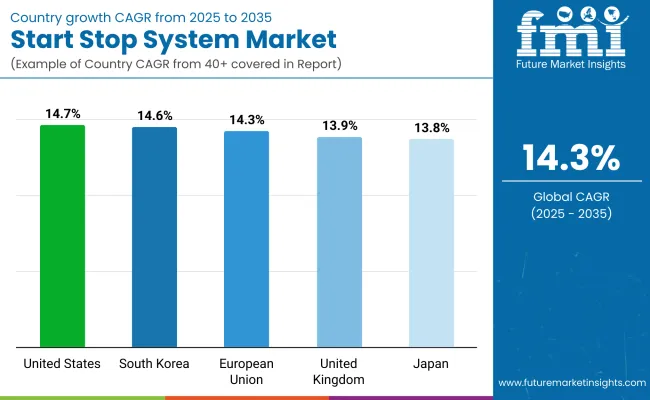
Automakers want to achieve CAFE targets that imply the USA start-stop system market should grow strongly. The technology has become increasingly standard on new passenger vehicles, most notably compact SUVs and sedans. Demand is also surging in the light commercial vehicle space amongst fleet operators looking to minimize fuel costs from idling.
In automotive Europe, Michigan and Ohio OEMs and Tier 1 suppliers make their systems more responsive and batteries more performing. Campaigns focused on clean transportation at the state level are also helping to raise public awareness of idle-reduction benefits.
| Country | CAGR (2025 to 2035) |
|---|---|
| United States | 14.7% |
In the UK, the primary factors driving the start-stop system market are the government regulations, which have been established to implement the CO₂ reduction program and low road taxes for low-emission vehicles. To meet stringent fleet-wide emissions targets under the Road to Zero strategy, car manufacturers are introducing start-stop capability in all petrol and diesel vehicles.
The move towards vehicles with idle-reduction systems is being driven by urban congestion zones and rising fuel prices. Innovations in start-stop optimized batteries and dual-clutch transmissions for smooth engine restarts in stop-and-go traffic further foster growth.
| Country | CAGR (2025 to 2035) |
|---|---|
| United Kingdom | 13.9% |
The European Union remains the key region for the adoption of start-stop systems due to the stringent Euro 6/7 emissions regulations and environmental directives under the Green Deal. Germany, France and Italy are the biggest adopters, where standard now on most new vehicles are start-stop systems.
OEMs are improving software-based features like battery management systems and regenerative braking integration. With a focus on sustainable mobility and energy efficiency, the EU is driving the development of advanced control units designed to enhance system durability and fuel economy, particularly in urban driving cycles.
| Country | CAGR (2025 to 2035) |
|---|---|
| European Union | 14.3% |
The start-stop system market is growing in Japan with its focus on both better fuel economy and environmental performance. Automakers are also pushed to integrate start-stop systems with hybrid and ICEV models as mandated by a government-led initiative called Top Runner Program.
Companies like Toyota and Honda, local OEMs, deploy advanced engine management algorithms to ensure smooth restarts and low engine vibrations. Japan’s high population density and urban congestion make start-stop systems well suited to its cities. Alongside this, partnerships with battery manufacturers are improving the development of longer-life AGM and EFB batteries for the assurance of reliable performance.
| Country | CAGR (2025 to 2035) |
|---|---|
| Japan | 13.8% |
South Korea’s automotive industry is widely adopting start-stop systems driven by country fuel economy standards and urban air quality targets. In densely populated areas, the Ministry of Environment also encourages less-idle technology to help limit particulate matter and nitrogen oxides to promote environmental conservation efforts.
Dashboard gauges are adopting start-stop when it is available, with Hyundai, Kia, and other domestic automakers rolling it into a wide range of models including hybrid variants. Advances in battery and control unit are helping the system respond faster for longer system life. Government incentives for green vehicle technologies are speeding up the market even more.
| Country | CAGR (2025 to 2035) |
|---|---|
| South Korea | 14.6% |
With global emission standards progressively getting stringent, the start stop system market is experiencing slow, but steady growth, along with rising consumer interest in fuel-efficient systems. Start stop systems turn off and restart the engine automatically when the vehicle is standing still, thereby reducing idling fuel consumption and tailpipe emissions.
Passenger cars and gasoline-powered internal combustion engines account for the majority of global market share among vehicle types and fuel segments, driven by volume sales, urban use patterns, and early adoption of technology. They are critical enablers for reaching near-term sustainability targets on internal combustion platforms, notably in nonhybrids.
Combined with global efforts to diminish vehicle CO₂ and urban air pollution caused by vehicles, we can see that start stop systems can be viewed as a cost effective bridging technology, alongside fully electrifying the vehicle as a whole, providing an improvement of up to +8% in fleet fuel economy in normal driving conditions.
Passenger cars gain traction due to regulatory mandates, OEM integration, and urban fuel economy optimization
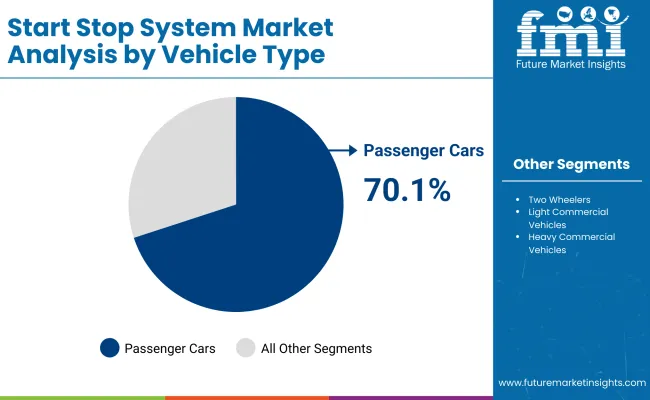
| Vehicle Type | Market Share (2025) |
|---|---|
| Passenger Cars | 70.1% |
Start-stop system market share diesel passenger cars are the top share of global om market is on the rise, the original factory had begun to use star stop system technology in midrange most of the high-end gasoline and diesel vehicles. Particularly in the urban segment, driving patterns consisting of many short-haul trips with extensive stops and traffic boost the efficiency advantages of start stop systems.
High performance starter motors and start stop systems are used by manufacturers which work alongside electrically managed sensors in the battery and smart control units which read the load in a vehicle and ensure the engine only shutdown when idling. Customers get savings on fuel, less noise during traffic stops and smoother restarts with capacitive energy storage in newer systems.
Because emissions targets are becoming more aggressive under the EU’s CO₂ fleet limits, China’s Stage VI, and USA CAFE standards, Passenger cars would need to implement incremental efficiency technologies either passive (e.g. weight reduction) or active (e.g. start stop systems) in order to be compliant without majorting redundancies in design and engineering efforts. While two wheelers and commercial vehicles are increasingly incorporating this technology, passenger cars have the highest share because of high penetration rates, good cost-to-value ratio, and relevance to urban operation.
Gasoline fuel type drives market use through system compatibility, mass-market deployment, and idle-cycle frequency
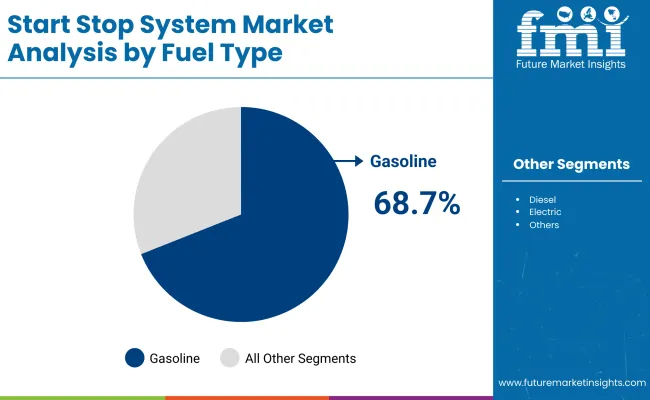
| Fuel Type | Market Share (2025) |
|---|---|
| Gasoline | 68.7% |
Gasoline-powered vehicles hold the highest adoption of start stop systems (and are also responsible for the dominant share of the global market), along with their stronger usage within urban settings, and their increased system compatibility with the prevailing spark-ignition engine designs. North American, European, and Asian OEMs incorporate start stop systems as standard and/or optional equipment throughout their gasoline passenger car lines.
Controlling the stop-start in gasoline engines is less complex as it has lower compression and faster combustion re-ignition compared to diesel engines. Such factors allow the technology to be implemented more easily without the need to alter engine architecture or accessory systems significantly.
Gasoline vehicles tend to sit idle more often, in congested urban centers where start stop systems offer the most efficiency benefits. When paired with eco-driving modes and respondative braking, gasoline vehicles enjoy significant decreases of consumption and CO₂ emissions.Electric vehicles address the need for emissions-free idling, and adoption of start stop systems in the commercial fleet is rapidly increasing; gasoline remains the dominant fuel segment today due to system maturity, global vehicle park share and compelling return on investment for both automakers and consumers.
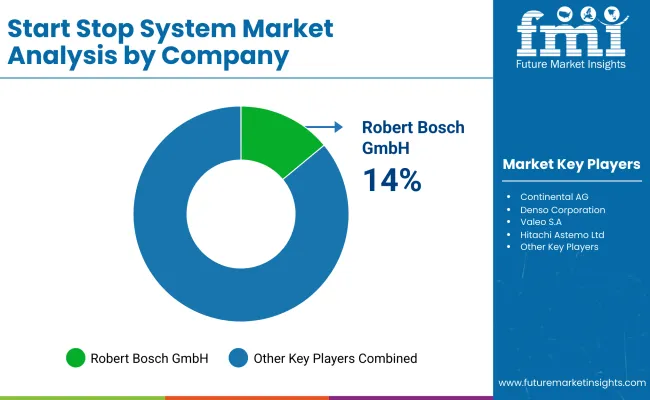
Demand for the start-stop system market; which is directly driven by rising global initiatives to cut down vehicular emissions as well as enhance fuel efficiency is its key insulation. These systems automatically turn off and restart the engine during periods of idling (e.g. at traffic lights) to reduce fuel consumption and emissions of CO₂.
Governments enact stricter emission regulations, and automakers apply start-stop technologies to both internal combustion and hybrid powertrains. Urban settings with frequent stop-and-go traffic offer the highest demand; however, its citizens will be well served by system benefits. This involves enhanced AGM/EFB batteries, intelligent alternators, and brake energy regeneration systems.
Market Share Analysis by Key Players & Start-Stop System Providers
| Company Name | Estimated Market Share (%) |
|---|---|
| Robert Bosch GmbH | 14-17% |
| Continental AG | 11-14% |
| Denso Corporation | 9-12% |
| Valeo S.A. | 7-10% |
| Hitachi Astemo Ltd. | 6-9% |
| Other Providers | 38-45% |
| Company Name | Key Offerings/Activities |
|---|---|
| Robert Bosch GmbH | In 2024, updated its iBoost smart alternator to improve battery recharging cycles; in 2025, launched modular start-stop ECUs for small and mid-size cars. |
| Continental AG | In 2024, expanded 12V and 48V start-stop systems for hybrid segments; in 2025, introduced predictive engine restart logic using driving pattern AI. |
| Denso Corporation | In 2024, optimized compact start-stop controllers for Japanese kei cars; in 2025, partnered with OEMs on noise and vibration suppression technologies. |
| Valeo S.A. | In 2024, released belt-driven starter generator (BSG) systems for European OEMs; in 2025, scaled lightweight power electronics to reduce vehicle mass. |
| Hitachi Astemo Ltd. | In 2024, enhanced dual-battery start-stop integration for SUVs and MPVs; in 2025, launched CAN-enabled ECUs for real-time start-stop diagnostics. |
Key Market Insights
Robert Bosch GmbH (14-17%)
Bosch remains the global leader in start-stop system technology with a broad portfolio that spans alternators, controllers, and smart sensors. In 2024, it launched the iBoost smart alternator, significantly improving battery regeneration during deceleration phases. In 2025, Bosch introduced modular ECUs adaptable across vehicle classes, from city cars to sedans. Bosch’s systems are widely adopted in European and Asian markets and support EU CO₂ fleet targets and vehicle electrification goals.
Continental AG (11-14%)
Continental is driving innovation through integrated electronics and powertrain components. In 2024, it released 12V and 48V start-stop modules for light hybrids, enhancing efficiency in premium vehicle segments. By 2025, Continental’s AI-enhanced start-stop logic allowed predictive engine restart based on traffic and driving patterns, improving responsiveness in congested conditions. Its compliance with Euro 6/7 and Chinese Stage VI emissions standards makes it a leading supplier for OEMs in regulatory-sensitive markets.
Denso Corporation (9-12%)
Denso focuses on compact, efficient components suited for urban and lightweight vehicles. In 2024, it introduced downsized start-stop controllers for kei cars and compact urban vehicles. In 2025, Denso co-developed damping technologies to reduce vibration and engine restart noise, improving comfort for end users. Denso’s solutions support Japanese fuel economy standards and align with broader decarbonization strategies in Southeast Asia.
Valeo S.A. (7-10%)
Valeo has built a strong presence in Europe by providing integrated starter generators and power electronics for hybrid and start-stop systems. In 2024, it deployed belt-driven starter generators (BSGs) that support extended engine-off durations without compromising climate control. In 2025, Valeo introduced lightweight, compact controller units that reduce vehicle curb weight. Its offerings cater to OEMs aiming for both emissions compliance and performance upgrades.
Hitachi Astemo Ltd. (6-9%)
Hitachi Astemo develops intelligent vehicle systems with an emphasis on diagnostics and performance monitoring. In 2024, it introduced dual-battery management systems to enhance start-stop reliability in larger vehicles such as SUVs and MPVs. In 2025, the company launched CAN-enabled ECUs capable of continuous self-diagnosis, supporting predictive maintenance. Hitachi’s focus on robustness and adaptability makes its systems suitable for global OEMs targeting diversified markets.
Other Key Players (38-45% Combined)
A range of regional suppliers, Tier II component makers, and hybrid system integrators are advancing the global start-stop system market. These include:
The overall market size for the start stop system market was USD 9,253.2 Million in 2025.
The start stop system market is expected to reach USD 35,217.2 Million in 2035.
The demand for start stop systems is rising due to increasing emphasis on fuel efficiency, stricter emission regulations, and growing adoption of eco-friendly automotive technologies. Passenger cars and gasoline-powered vehicles continue to be key contributors to market expansion as automakers integrate energy-saving features across their fleets.
The top 5 countries driving the development of the start stop system market are China, the USA, Germany, Japan, and India.
Passenger cars and gasoline-powered vehicles are expected to command a significant share over the assessment period.






Full Research Suite comprises of:
Market outlook & trends analysis
Interviews & case studies
Strategic recommendations
Vendor profiles & capabilities analysis
5-year forecasts
8 regions and 60+ country-level data splits
Market segment data splits
12 months of continuous data updates
DELIVERED AS:
PDF EXCEL ONLINE
ICE Start And Stop System Market Size and Share Forecast Outlook 2025 to 2035
Motorcycle Start Stop Systems Market
Starter Fertilizers Market Size and Share Forecast Outlook 2025 to 2035
Starter Cultures Market Analysis by Microorganism Type, Type, Form, Growth Temperature, Application, Composition, and Region Through 2035
Starter Feed Market Analysis by Type, Ingredient, Livestock, Form, and Region Through 2035
Meat Starter Cultures Market Size and Share Forecast Outlook 2025 to 2035
Black Start Generator Market
Engine Starter Fluid Market Growth - Demand, Trends & Forecast 2025 to 2035
Vehicle Starter Motor Market
Organic Starter-Grower Chicken Feed Market
Automotive Starter And Alternator Market Size and Share Forecast Outlook 2025 to 2035
Automotive Starter Motor Market Size and Share Forecast Outlook 2025 to 2035
Motor Soft Starters Market Trend Analysis Based on Voltage, End-Use, and Region 2025 to 2035
Automotive Starting System Market Size and Share Forecast Outlook 2025 to 2035
Automotive Start-Stop Battery Market Size and Share Forecast Outlook 2025 to 2035
Vehicle Jump Starter Market Size and Share Forecast Outlook 2025 to 2035
Enclosed Motor Starter Market Growth – Trends & Forecast 2024-2034
Two Wheeler Electric Starter Magnet Market
Automotive Integrated Starter Generator Units Market Size and Share Forecast Outlook 2025 to 2035
Residential Automatic Motor Starter Market Size and Share Forecast Outlook 2025 to 2035

Thank you!
You will receive an email from our Business Development Manager. Please be sure to check your SPAM/JUNK folder too.
Chat With
MaRIA